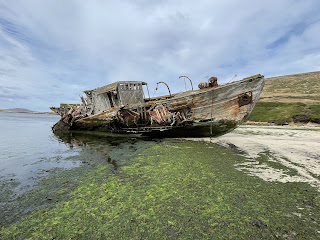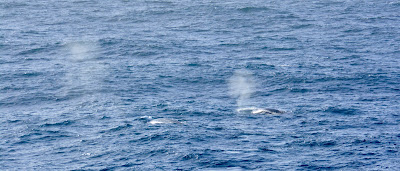Brazil Part 1
Ilhabela, Rio de Janeiro and Armacao dos Buzios
February 25, 2023
After several days at sea, we arrived at Ilhabela, on Sao Sabastiono Island, south of Rio de Janeiro about 200 NM.
Ilhabela means “beautiful island” and is famous for gorgeous beaches, dense tropical forests and hundreds of waterfalls. Before the Portugal colonized Brazil in 1500, the island was the home of an indigenous tribe called Tupinambas. These people called the island “Ciribai” which means tranquil place. The island is now a resort playground for both Sao Paulo and Rio de Janeiro, with several large marinas and many small hotels. We anchored off of Ilhabela’s historic town center and tendered ashore for a variety of tours. Patrick picked a 4×4 excursion to several waterfalls and Currall Beach for a swim break.
Currall Beach
The water was warm and the surf low, so water entry was easy. The beach was nice, but to get a seat or lounge chair one had to buy some drinks or food from the restaurants that controlled each section of the beach. However, the prices were reasonable and the Caipirinha’s were good, so it was very acceptable. Due to recent heavy rains and mudslides, one of the waterfalls was not accessible. The historic city center is dominated by a church and naval museum and many small shops and restaurants.
Naval Museum
Historic Waterfront – Ilhabela
After a full day, Seabourn Quest headed for Rio de Janeiro, getting to the pilot station at 0230, and docking at the cruise terminal at 0430 on February 26 for an overnight stay.
February 26, 2023 – Rio de Janeiro
Rio de Janeiro literally means “River of January”, and is the 6th most populated city in the Americas. Part of the city has been designated as a World Heritage Site. Rio was founded in 1565 by Portugal and in 1763 became the capital of the State of Brazil, a state in the Portuguese Empire. From 1808 to 1822 it was actually the capital of the Portuguese empire under Queen Maria I and later her son Joao, who raised Brazil to the dignity of a kingdom, within the United Kingdom of Portugal, Brazil and the Algarves. In 1822, the Brazilian war of independence began and Rio became the capital of the Kingdom of Brazil until 1889 and then the capital of the Republic of Brazil until 1960 when the capital was transferred to the new city of Brasilia.
Rio is known for beaches, landmarks such as the statue of Christ the Redeemer atop Corcovado mountain, Sugarloaf mountain with the cable car, Carnival, bossa nova music, and the samba.
The cruise terminal is located in the Gamboa district close to the original downtown area on Guanabara Bay. Guanabara Bay is reputed to be the largest bay in the world by volume. We were only a few blocks from the Carnival Stadium and there were still several floats on the streets in the morning from the last night of Carnival, although smaller celebrations continued through the evening. Patrick joined a Seabourn Ventures nature walk in the botanical gardens which back up to the Tijuca State Forest.
The drive to the gardens took 45 minutes. Due to the many road closures for Carnival, we actually got a good look at many of the neighborhoods of Rio. Our route included a trip through the tunnel bored through Corcovado Mountain which is dominated by the Christ the Redeemer statue at the very top. The botanical gardens were started in the 1800’s by the king of Portugal and Brazil. It is divided into many sections and more than half the species were imported as gifts to the king. There was an extensive collection of orchids and 18 different species of palm trees.
Jackfruit or Durian
Royal Palms and Statue of gardens founder
Acai berries
Returning to the ship mid-afternoon we prepared for an evening gala event for those guests on the entire Grand Americas cruise. The event was held at Casa das Canoas, designed by Oscar Niemeyer in 1951. It is now an event venue but was originally a private residence perched high on the hills above the beaches in the Canoas neighborhood of Barra de Tijuca, a suburb of Rio. Oscar Niemeyer is also the person who designed many of the public buildings in Brasilia, the purpose built capital of Brazil. After appetizers, cocktails, dinner and a Carnival show, it was after 2300 when we finally returned to the ship.
February 27, 2023 – Rio de Janeiro
We left on a private city tour with a driver and guide at 0830 and headed first for the Corcovado cog railway to ascend the mountain and view the “Christ the Redeemer” statue at the top. The crowds were already intense when we reached the end of the cog railway, which has new cars since we visited in 2008, and ascended the 220 steps to the top. People were pretty good about giving everyone space to get their pictures of both the statue and the surrounding hills and beaches. Returning to the bottom we headed to Sugar Loaf mountain and the two-stage aerial trams traveling 400 meters to the top. The gondolas’s for the aerial trams are also new since our 2008 visit. The views of the beaches and city were spectacular. By the time we descended to the base once again it was time for lunch. Our guide took us to the Copacabana Palace Hotel for a traditional Brazilian BBQ at the Churrascaria Palace, located across the street from the hotel just off the beach. Here they bring around skewers of meats and for a fixed price you can eat as much of the different steaks, chicken, fish, sausages and other cuts of meat, as well as enjoying an extensive buffets of salads, other hot dishes and desserts.
Christ the Redeemer statue
Church of the Immaculate Conception
Following lunch we walked across the street to Copacabana beach and enjoyed the scenery before heading back to the ship, stopping for photos at several cathedrals and the very modern science museum close to the ship. The Church of the Immaculate Conception is the home church that spurred the construction of the Christ the Redeemer statue. We were unable to enter any museums since all museums in Rio are closed on Mondays.
The ship departed Rio at 2100, passing by Sugar Loaf and the domestic airport in near darkness, heading back out into the South Atlantic ocean for our next stop in the morning.
February 28, 2023 – Armacao dos Buzios
This small but upscale community stretches some 8 KM along the shore, with many beaches and small bays. The former fishing village of Buzios became a favored destination for jet-setters with the visit of Bridgett Bardot in the 1960’s. In the past the village was a focal point for slave traders, Portuguese and French pirates. Today Buzios is one of the most charming destinations in the Brazil.
Seabourn Quest anchored about ¾ NM off the main harbor, filled with boats on moorings, and began tender operations shortly after 0800. Patrick did a kayak tour, a real change from Antarctica and the Falklands since we could wear shorts, t-shirts and sandals with just a kayak vest rather than suit up in a dry suit. We took a zodiac ride to a beach several KM west of town and entered the kayaks from the zodiacs. Our route took us along the beaches back towards the main harbor, with birds, sea turtles, snorkelers, divers, water taxis, swimmers and an amazing variety of swimwear on the beach including what only be described as dental floss bikinis. The wind had picked up and rounding the points into the next beaches was a lot of work in seas up to 3 feet.
The ship departed at 1500 with a sail away celebration around the pool in 90 degree clear skies. The breeze kept it comfortable.
Later that evening we celebrated Miriam’s birthday in the Thomas Keller Grill, with a special cake arranged by Ruben, one of maitre’d’s on the ship who has been on several of our other cruises.















































































